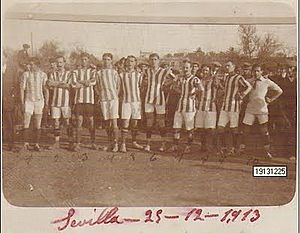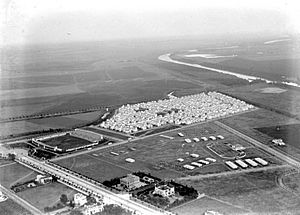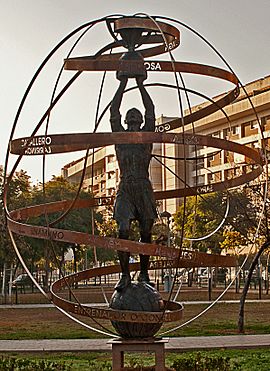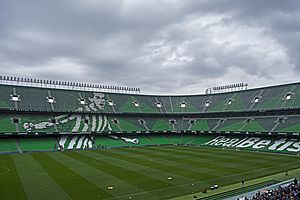Real Betis facts for kids
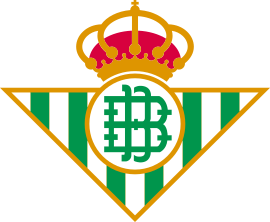 |
|||
| Full name | Real Betis Balompié, S.A.D. | ||
|---|---|---|---|
| Nickname(s) | Los Verdiblancos Heliopolitanos (Heliopolitans) El Glorioso (The Glorious) Béticos (supporters) |
||
| Short name | Betis | ||
| Founded | 12 September 1907 (as Sevilla Balompié) | ||
| Ground | Estadio La Cartuja | ||
| Capacity | 70,000 | ||
| President | Ángel Haro García | ||
| Head coach | Manuel Pellegrini | ||
| League | La Liga | ||
| 2022–23 | La Liga, 6th of 20 | ||
|
|
|||
Real Betis Balompié, often called Real Betis, is a professional football club from Seville, Andalusia, Spain. They play in La Liga, which is the top football league in Spain. Their home games are played at the Estadio Benito Villamarín, which can hold 60,721 fans.
Real Betis has won the Spanish league title once, in 1935. They have also won the Copa del Rey (King's Cup) three times: in 1977, 2005, and 2022. The club has had a challenging history with many ups and downs. Because of this, their famous motto is ¡Viva el Betis manque pierda!, which means "Long live Betis even if they lose!"
Contents
Club History
The name "Betis" comes from Baetis, which was the Roman name for the Guadalquivir river. This river flows through Seville. The word Real means 'Royal' and was added in 1914. This happened after King Alfonso XIII became a supporter of the club.
How Real Betis Started
The first football club in Seville was Sevilla, started in 1905. A second club, España Balompié, began in September 1907. "Balompié" is a Spanish word that means "football." This is different from the more common word "fútbol."
Balompié was founded by students from a local school. It was officially recognized in 1909 as Sevilla Balompié. However, 1907 is still seen as the club's official start date.
Later, some people left Sevilla FC and formed a new club called Betis Football Club. In 1914, this club joined with Sevilla Balompié. That same year, the club received royal support and changed its name to Real Betis Balompié. Fans used to call the club Balompié and themselves Los Balompedistas. But by the 1930s, Betis and Béticos became the common names.
Real Betis first wore blue jerseys and white shorts. This was simply because these colors were easy to find. However, one of the club's founders, Manuel Ramos Asensio, had studied in Scotland. He got green and white fabric from Celtic, a Scottish team. These colors also matched the flag of Andalusia. Ramos changed Celtic's horizontal stripes to vertical ones for Betis' shirts. No other Spanish club used these colors at the time.
Winning the League in the 1930s
During the Spanish Second Republic (1931–1939), the club was known as Betis Balompié. This was because royal titles were not used then. The club returned to its full name after the Spanish Civil War.
On June 21, 1931, Betis played in their first Copa del Presidente de la República final. They lost 3–1 to Athletic Bilbao. In 1932, Betis celebrated their 25th anniversary by winning their first Segunda División title. This made them the first club from Andalusia to play in La Liga.
On April 28, 1935, Betis won La Liga. This is their only top-division title so far. They won by just one point over Madrid FC. Their coach was Patrick O'Connell from Ireland.
A year later, the team's success faded. Many players left because of money problems and the upcoming Civil War. Just 15 months after winning the league, only two players from the 1935 team remained. The league stopped during the Civil War (1936–1939). When it started again in 1939, Betis was relegated (moved down a division).
Tough Times and Strong Support
After a short return to the top division, the club continued to struggle. In 1947, they reached their lowest point, being relegated to the Tercera División. Many fans believe the ten years Betis spent in this division helped shape the club's "identity" and "soul." During this time, Betis became known for having huge crowds at their home games and massive support at away matches. This was called the "Green March."
When the team returned to the second division in 1954, they became the only club in Spain to have won titles in all three major divisions. Much credit for this goes to chairman Manuel Ruiz Rodríguez.
Benito Villamarín's Impact
In 1955, Manuel Ruiz Rodríguez stepped down. Benito Villamarín, who would become Betis' most famous president, took over. During his time, Betis returned to the top division in 1958–59. They finished third in 1964.
Villamarín bought the Estadio Heliópolis in 1961. This was a very important moment for the club. The stadium was later named Estadio Benito Villamarín after him. Villamarín left his role in 1965 after ten years.
Just one year after Villamarín left, the club was relegated again. They went up and down between divisions for a while. Finally, they stayed in the top league from 1974–75 onwards.
First Copa del Rey Title
On June 25, 1977, Betis played Athletic Bilbao in the Copa del Rey final. The game ended 2–2. Betis won 8–7 in a long penalty shootout with 21 penalties taken. This was their first Copa del Rey title. They also finished fifth in the league that season.
After this win, Betis played in the European Cup Winners' Cup. They beat Milan and reached the quarter-finals. There, they lost to Dynamo Moscow. Even with their strong European performance, the team was relegated from the league.
The next year, Betis returned to the top league. The club then had a good period, finishing in the top six three times. They also qualified for the UEFA Cup in 1982 and 1984.
In 1982, the Benito Villamarín stadium hosted two matches for the 1982 FIFA World Cup. It also saw the Spanish national team's famous 12–1 win against Malta.
Changes in Ownership
In 1992, new league rules meant Betis had to raise a lot of money. Fans helped raise a large amount. Then-vice-president Manuel Ruiz de Lopera provided financial support and became the main owner. The team avoided relegation.
On September 11, 1994, Real Betis played its 1,000th game in La Liga.
Later, in 2010, there were changes in the club's ownership. A judge appointed former Betis player and legend Rafael Gordillo to manage the club's shares. This was to make sure decisions were made for the club's benefit.
Back to La Liga and European Football
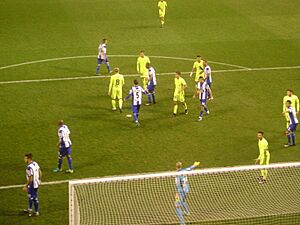
Under coach Pepe Mel, Betis started the 2011–12 season well. They finished 13th in their first season back in La Liga.
In the 2012–13 season, Betis finished seventh in La Liga. This meant they qualified for the 2013–14 UEFA Europa League. It was their first time in European competition since the 2005–06 Champions League. They reached the quarter-finals, where they lost to their city rivals, Sevilla.
Betis was relegated from La Liga in 2013–14. However, they immediately returned as champions the next season.
In the 2017–18 season, under coach Quique Setién, Betis finished sixth in La Liga. This earned them a spot in the Europa League. The 2018–19 season was also good. The club reached the Copa del Rey semi-finals. They also won their group in the Europa League before being knocked out.
On July 9, 2020, Manuel Pellegrini became Betis manager. He led Betis to a sixth-place finish and a Europa League spot in the 2020–21 season. This was a big improvement from the previous season.
On April 23, 2022, Betis won the Copa del Rey final against Valencia. The match was 1–1 after extra time, and Betis won 5–4 on penalties. This was their first trophy in 17 years.
Under Pellegrini, the club has been very consistent. They qualified for the UEFA Europa League for three seasons in a row. They finished fifth in 2021-22 and sixth in 2022-23. In the 2023-24 season, they finished seventh and qualified for the Conference League. They even reached their first European final in the Conference League but lost 1-4 to Chelsea.
Seville Derby

Betis has a long-standing rivalry with their city neighbors, Sevilla FC. This rivalry is known as El Derbi Sevillano. The two teams have played each other 114 times in official games. Sevilla has won 45% of these matches.
The first game between the two clubs was on February 8, 1915. Sevilla won 4–3, but the game was stopped early because of angry fans.
In 1916, the first official derby of the Seville area was held. It was called the Copa Andalucía. Sevilla won this cup 14 times, while Betis won it once. One famous game in 1918 saw Sevilla win 22–0 after Betis sent their youth team.
The teams first met in the league in 1928–29. Both teams won their home games. They played for the first time in the top Spanish division in the 1934–35 season. Betis won the national championship that year.
Some matches have been affected by violence. In 2007, a Copa del Rey match was stopped after Sevilla's manager was hit by a bottle. The game was finished three weeks later without any fans.
On November 9, 2019, over 10,000 Betis fans visited the team's training before a derby game. This showed their strong support.
Derby Statistics
| Competition | Matches | Betis wins | Draws | Sevilla wins | Betis goals | Sevilla goals |
|---|---|---|---|---|---|---|
| Primera División | 106 | 30 | 27 | 49 | 125 | 160 |
| Segunda División | 14 | 4 | 4 | 6 | 15 | 20 |
| Copa del Rey/Copa del Generalísimo | 19 | 5 | 5 | 9 | 21 | 32 |
| UEFA Europa League | 2 | 1 | 0 | 1 | 2 | 2 |
| Overall | 141 | 40 | 36 | 65 | 163 | 214 |
Betis in European Competitions
Betis has played in several European football tournaments.
| Competition | Played | Won | Drew | Lost | GF | GA | GD | Win% |
|---|---|---|---|---|---|---|---|---|
| UEFA Champions League | 8 | 3 | 2 | 3 | 6 | 9 | −3 | 37.50 |
| UEFA Cup Winners' Cup | 12 | 5 | 3 | 4 | 15 | 13 | +2 | 41.67 |
| UEFA Cup / UEFA Europa League | 70 | 36 | 14 | 20 | 102 | 71 | +31 | 51.43 |
| UEFA Europa Conference League / UEFA Conference League | 19 | 9 | 5 | 5 | 29 | 18 | +11 | 47.37 |
| Total | 109 | 53 | 24 | 32 | 152 | 111 | +41 | 48.62 |
Source: UEFA.com
Pld = Matches played; W = Matches won; D = Matches drawn; L = Matches lost; GF = Goals for; GA = Goals against; GD = Goal difference.
Team Statistics
Real Betis has played:
- 60 seasons in La Liga (top division)
- 28 seasons in Segunda División (second division)
- 7 seasons in Tercera División (third division)
- They have played in the UEFA Champions League once.
- They have played in the UEFA Cup 7 times.
- They have played in the UEFA Cup Winners' Cup 2 times.
Recent La Liga Seasons
Real Betis was relegated from La Liga in 1999–2000 and 2013–14. But they were promoted back to the top league right away both times.
| Season | Pos | Pld | W | D | L | GF | GA | Pts |
|---|---|---|---|---|---|---|---|---|
| 1996–97 | 4th | 42 | 21 | 14 | 7 | 81 | 46 | 77 |
| 1997–98 | 8th | 38 | 17 | 8 | 13 | 49 | 50 | 59 |
| 1998–99 | 11th | 38 | 14 | 7 | 17 | 47 | 58 | 49 |
| 1999–2000 | 18th | 38 | 11 | 9 | 18 | 33 | 56 | 42 |
| 2001–02 | 6th | 38 | 15 | 14 | 9 | 42 | 34 | 59 |
| 2002–03 | 8th | 38 | 14 | 12 | 12 | 56 | 53 | 54 |
| 2003–04 | 9th | 38 | 13 | 13 | 12 | 46 | 43 | 52 |
| 2004–05 | 4th | 38 | 16 | 14 | 8 | 62 | 50 | 62 |
| 2005–06 | 14th | 38 | 10 | 12 | 16 | 34 | 51 | 42 |
| 2006–07 | 16th | 38 | 8 | 16 | 14 | 36 | 49 | 40 |
| 2007–08 | 13th | 38 | 12 | 11 | 15 | 45 | 51 | 47 |
| 2008–09 | 18th | 38 | 10 | 12 | 16 | 51 | 58 | 42 |
| 2011–12 | 13th | 38 | 13 | 8 | 17 | 47 | 56 | 47 |
| 2012–13 | 7th | 38 | 16 | 8 | 14 | 57 | 56 | 56 |
| 2013–14 | 20th | 38 | 6 | 7 | 25 | 36 | 78 | 25 |
| 2015–16 | 10th | 38 | 11 | 12 | 15 | 34 | 52 | 45 |
| 2016–17 | 15th | 38 | 10 | 9 | 19 | 41 | 64 | 39 |
| 2017–18 | 6th | 38 | 18 | 6 | 14 | 60 | 61 | 60 |
| 2018–19 | 10th | 38 | 14 | 8 | 16 | 44 | 52 | 50 |
| 2019–20 | 15th | 38 | 10 | 11 | 17 | 48 | 60 | 41 |
| 2020–21 | 6th | 38 | 17 | 10 | 11 | 50 | 50 | 61 |
| 2021–22 | 5th | 38 | 19 | 8 | 11 | 62 | 40 | 65 |
| 2022–23 | 6th | 38 | 17 | 9 | 12 | 46 | 41 | 60 |
| 2023–24 | 7th | 38 | 14 | 15 | 9 | 48 | 45 | 57 |
| 2024–25 | 6th | 38 | 16 | 12 | 10 | 57 | 50 | 60 |
Players
First-Team Squad
|
|
Players on Loan
|
|
Retired Jersey Numbers
26 ![]() Miki Roqué (This number was retired after his passing) (2009–12)
Miki Roqué (This number was retired after his passing) (2009–12)
Player Records
Most Appearances
| Rank | Player | Matches |
|---|---|---|
| 1 | 528 | |
| 2 | 378 | |
| 3 | 343 | |
| 4 | 337 | |
| 5 | 328 | |
| 6 | 315 | |
| 7 | 305 | |
| 8 | 303 | |
| 9 | 300 | |
| 10 | 285 |
Most Goals
| Rank | Player | Goals |
|---|---|---|
| 1 | 148 | |
| 2 | 109 | |
| 3 | 98 | |
| 4 | 93 | |
| 5 | 92 | |
| 6 | 80 | |
| 7 | 77 | |
| 8 | 68 | |
| 9 | 59 | |
| 10 | 54 |
Club Management
Board of Directors
- President: Ángel Haro García
- Vice-president: José Miguel López Catalán
- Board members: José Montoro Pizarro, Tomás Solano Franco, Ernesto Sanguino Gómez, José Maria Pagola Serra, Adrián Fernández Romero, María Victoria López Sánchez, Rafael Salas Garcia, Ramón Alarcón Rubiales, Cayetano García de la Borbolla Carrero
- Ambassadors: Rafael Gordillo, Andrés Saavedra
Coaching Staff
- Head coach: Manuel Pellegrini
- Assistant coach: Rubén Cousillas
- Fitness coach: José Cabello, Félix Fernández
- Goalkeeper coach: Toni Doblas
Club Achievements
Real Betis Balompié has won all the main national championships in Spain.
League Titles
- La Liga (Top Division)
- Winners (1): 1934–35
- Segunda División (Second Division)
- Winners (7): 1931–32, 1941–42, 1957–58, 1970–71, 1973–74, 2010–11, 2014–15
- Tercera División (Third Division)
- Winners (1): 1953–54
Cup Titles
- Copa del Rey (King's Cup)
- Winners (3): 1976–77, 2004–05, 2021–22
- Copa Federación de España
- Winners (1): 1953–54
European Competitions
- UEFA Conference League
- Runners-up (1): 2024-25
Stadium
When Real Betis first started, they played at the Campo del Huerto de Mariana. Over the years, they moved to different fields. In 1918, Real Betis moved to the Campo del Patronato Obrero. Their first game there was against Sevilla, which they lost 5–1.
In 1929, the Estadio de la Exposición was built. This is the old name for Betis' current home. Real Betis officially moved into this stadium in 1936.
The Estadio Benito Villamarín is Real Betis' home ground. It can hold 60,720 fans. In the 2000s, it was named Estadio Manuel Ruiz de Lopera after the club's owner. He planned to build a new stadium, but only half of it was changed. On October 27, 2010, the stadium went back to its original name, Estadio Benito Villamarín.
Team Colors
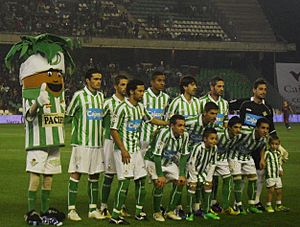
In its early years, Sevilla Balompié wore blue shirts and white shorts. These colors were easy to find. But in late 1911, the team started wearing green and white striped shirts. These were inspired by Celtic from Scotland. Manuel Asensio Ramos, who had studied in Scotland, brought the idea. He changed Celtic's horizontal stripes to vertical ones for Betis.
When the team became Real Betis Balompié in 1914, they tried different kits. These included yellow and black stripes, and green T-shirts. They even went back to blue tops and white shorts. By the late 1920s, Betis was wearing green and white stripes again. Around this time, the region of Andalusia also officially adopted green and white as its colors.
Since then, the green and white striped shirt has been Betis' main jersey. They have also worn black and green shorts, as well as white shorts.
See also
 In Spanish: Real Betis Balompié para niños
In Spanish: Real Betis Balompié para niños


